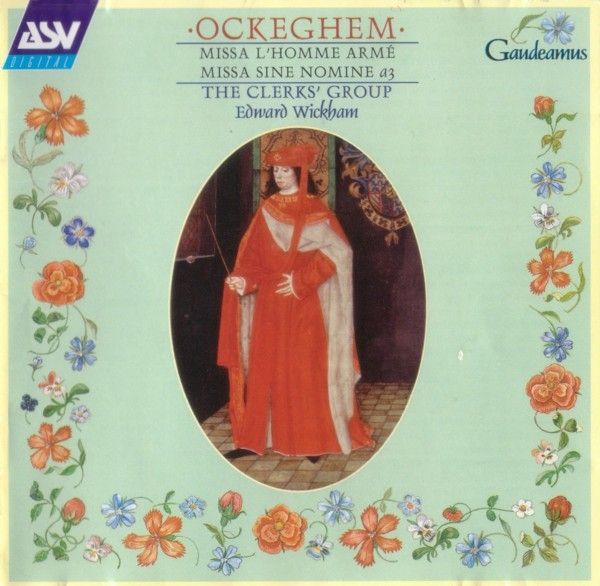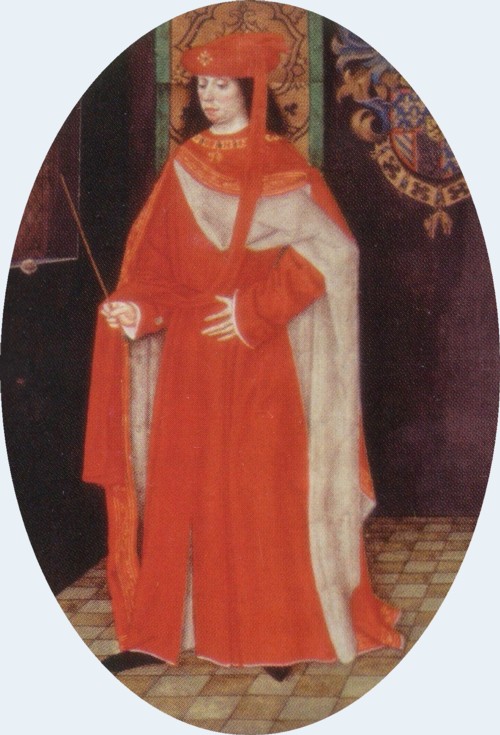Johannes OCKEGHEM. Missa L'homme armé · Missa Sine nomine a 3 / The Clerks' Group
Robert MORTON. Il sera pour vous ~ L'homme armé · Philippe BASIRON. Salve Regina (attr. Ockeghem)

medieval.org
AS&V "Gaudeamus" CD GAU 204
2000
Robert MORTON
(d. 1475)
1. Il sera pour
vous ~ L'homme armé [2:24]
soprano CL, tenors, bass EW
Johannes OCKEGHEM
(c. 1410-1497)
Missa L'homme
armé
soprano RO, altos RB WM, tenors, basses
2. Kyrie [2:05]
3. Gloria [4:42]
4. Credo [6:42]
5. Sanctus and Benedictus [6:39]
6. Agnus Dei [5:36]
Philippe BASIRON
(d.c. 1497 / attrib. Ockeghem)
7. Salve regina
[4:52]
altos RB LB, tenors, basses JA EW
Johannes OCKEGHEM
Missa Sine nomine a 3
soprano CL, alto LB, tenors
8. Kyrie [2:43]
9. Gloria [4:34]
10. Credo [6:04]
11. Sanctus and Benedictus [6:42]
12. Agnus Dei [4:32]
THE CLERKS' GROUP
Edward Wickham
Soprano: Carys Lane, Rebecca Outram
Alto: Robin Blaze, Lucy Ballard, William Missin
Tenor: Tom Raskin, Matthew Vine
Bass: Jonathan Arnold, Robert Macdonald, Edward Wickham
Produced by: Jonathan Freeman-Attwood
Recorded by: David Wright/Gemini Sound
Recorded in: St Andrew's Church, West Wratting, 1 & 23 February 1999
Designed by: Studio B, The Creative People
Cover: Charles, Duke of Burgundy from the Rules and Ordinances of the
Order of the Golden Fleece,
courtesy of the British Library/Bridgeman Art Library, London/New York

From the outset of his compositional career, Ockeghem seems to have
been intent upon innovation. His earliest surviving four-voice mass
— Missa Caput (recorded by The Clerks' Group on ASV CD
GAU 186) — announces its revolutionary principles in the
astonishing opening bars: under the guise of a traditional four-voice
scoring he turns the ensemble on its head, driving the cantus firmus
into the bass and producing the low sonorities which are to be a
hallmark of Ockeghem's vocal writing.
Missa L'homme armé is likely to date from the late 1450s
— only a few years after Missa Caput — and some of
the same techniques can be found here. In the Credo and Agnus Dei
movements Ockeghem again instructs the tenor to transpose the tune, so
that a rearrangement of vocal forces is necessary. But in many other of
its features, Missa L'homme armé is a very different
composition from its predecessor. True to form, Ockeghem never stays
still.
The character of the mass is defined throughout by the cantus firmus f
it might even be said that in no other mass is Ockeghem's polyphony so
controlled by the nature of the borrowed material. As a cantus firmus,
the Caput melisma — extracted from a long section of Sarum chant
— is awkward and prolix. Not so the L'homme armé
tune, which is compact, rhythmically well-defined and — perhaps
most importantly — full of cadential promise. Wringing a strong
cadence out of the Caput melisma requires great ingenuity: the L'homme
armé tune offers them up on a plate. And so, while Missa
Caput is seen as the quintessence of Ockeghem's "seamless" style of
polyphonic composition, Missa L'homme armé is regarded
as contained, controlled and, perhaps, less inspired.
There is only so much truth in these caricatures. Certainly the music
is arranged into shorter paragraphs than is common in Ockeghem's music:
individual phrases are often shorter, and these phrases are defined
both by textual and harmonic cadences. Ockeghem's polpyony in this form
is easier to understand on a first listening. Yet this is not always
the case. The first section of the Gloria is a dense polyphonic jungle,
and reminds one that this is also the composer of Missa Fors
Seulement, for whose Gloria one needs a map and compass. More
importantly, in Missa Caput and Missa L'homme armé
— respectively, Ockeghem's most and least opaque four-voice
masses — we find on display a common approach to the task of what
one might call the narration of the cantus firmus.
Only the most attentive listener will be able to follow and remember
the twists and turns of the Caput melisma as it winds its way through
Ockeghem's earlier mass. But for those prepared to put in the hours,
the rewards are great. As the contours of the tune become more familiar
with repetition through the five movements, so Ockeghem's skill in
re-telling the tune with variations becomes more apparent. In Missa
L'homme armé the story is much easier to remember.
Originally — it has been assumed — some kind of street-cry,
either ironic or horribly real, to warn the citizenry of a town to arm
against an invader, L'homme armé is a simple, catchy
tune. It blazes a trail through Ockeghem's polyphony such that we
rarely lose sight of it. By the time we reach the third petition of the
Agnus Del, therefore, the composer has established a set of
expectations which he then inventively and dramatically plays upon. The
narrator in this culminating movement is the bass, who sings the tune
in note values which — relative to the surrounding music —
sound augmented. The tune is flattened at crucial moments and
interpolated with commentary by the upper voices. And the final
statement, taking the bass to low G, embodies that paradox in all great
stories which are re-told endlessly — that something expected can
take one thrillingly by surprise.
That this "narrative" approach to cantus firmus treatment is truly
innovative does not, sadly, provide any more than another hypothetical
reason to support the claim that Ockeghem composed the very first L'homme
armé mass. Claimants to this particular distinction include
Dufay, Busnois, Caron and Regis, and there are good cases to be made
for most of them. The tune does not survive in its raw, monophonic
form, but one of its earliest appearances in polyphony is in the
rondeau Il sera pour vous, which has been attributed to the
Burgundian composer Robert Morton. The text refers to Morton's
colleague at the Burgundian court, Symon le Breton, whose chivalric
aspirations are underlined — or mockingly undermined — by
the tenor and contratenots rendition of L'homme armé. In
the final verse of our performance here, we have used a later version
of the song, expanded to four voices to satisfy a later demand for
music with low contratenor.
The attribution of Missa Sine nomine for three voices to
Ockeghem has been the subject of much speculation, and must remain
under suspicion. It is associated with Ockeghem in its only complete
source which dates from the 1490s, at least 40 years after the work's
composition; and such is the stylistic disparity between this and
Ockeghem's other works — be they three or four part — that
doubts are valid. On the other hand, one should judge the work in the
light of what has already been said about the changing face of
Ockeghem's music. It is by no means inconceivable that Ockeghem could
have penned the work in his youth, in a style which is more borrowed
than his own. Even as a piece of juvenilia, Missa Sine nomine
is an attractive and engaging work.
Nor is it the case that there are no features in the mass which could
be regarded as Ockeghemian. In the midst of the uncharacteristically
strict imitation, there are also many instances of that technique of
imitation by free association which has given Ockeghem his reputation
as an "irrational" composer. Again, it is the Agnus Dei where the
writing is shown at its best: melismas on "mundi, miserere nobis" both
mimic and re-invent melodies remembered and re-echoed from other
voices. This is fine three-part writing, whomever it is by.
Firmly in the category of "dubia" is the Salve Regina, which is also
— and more convincingly — attributed to Philippe Basiron, a
composer who moved in the orbit of Ockeghem and who may have been
deprived of the honour of this attribution as a result. The chant here
appears in all four voices at various times, though it is the top two
voices who are responsible for most of the contrapuntal activity.
© Edward Wickham, 2000



